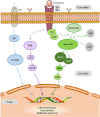Which patients are prone to suffer liver metastasis? A review of risk factors of metachronous liver metastasis of colorectal cancer
- PMID: 35879739
- PMCID: PMC9310475
- DOI: 10.1186/s40001-022-00759-z
Which patients are prone to suffer liver metastasis? A review of risk factors of metachronous liver metastasis of colorectal cancer
Abstract
Background: In recent years, with the increasing incidence of colorectal cancer (CRC) and its high fatality rate, CRC has seized the attention of the world. And liver metastasis, as the main cause of death of CRC, has become the leading cause of treatment failure in CRC, especially metachronous liver metastasis, have caused patients who underwent bowel resection to experience multiple tortures.
Main body: Metachronous liver metastasis has severely affected the quality of life and prognosis of patients. Therefore, in this review, we discuss risk factors for metachronous liver metastasis of CRC, which is the premise for effective intervention for CRC patients who suffer metachronous liver metastasis after undergoing surgery, as well as the signaling pathways associated with CRC.
Conclusion: The occurrence of metachronous liver metastasis is closely related to histology-based prognostic biomarkers, serum-based biomarkers, tumor microenvironment, pre-metastatic niche, liquid biopsy and tissue-based biomarkers. Further research is required to explore the risk factors associated with liver metastasis of CRC.
Keywords: Biomarkers; Colorectal cancer; Metachronous liver metastasis; Risk factors.
© 2022. The Author(s).
Conflict of interest statement
The authors declare that they have no competing interests.
Figures
References
-
- Sung H, Ferlay J, Siegel RL, Laversanne M, Soerjomataram I, Jemal A, et al. Global cancer statistics 2020: GLOBOCAN estimates of incidence and mortality worldwide for 36 cancers in 185 countries. CA Cancer J Clin. 2021;71(3):209–249. - PubMed
-
- Stewart CL, Warner S, Ito K, Raoof M, Wu GX, Kessler J, et al. Cytoreduction for colorectal metastases: liver, lung, peritoneum, lymph nodes, bone, brain. When does it palliate, prolong survival, and potentially cure? Curr Probl Surg. 2018;55(9):330–379. doi: 10.1067/j.cpsurg.2018.08.004. - DOI - PMC - PubMed
-
- Tsilimigras DI, Ntanasis-Stathopoulos I, Bagante F, Moris D, Cloyd J, Spartalis E, et al. Clinical significance and prognostic relevance of KRAS, BRAF, PI3K and TP53 genetic mutation analysis for resectable and unresectable colorectal liver metastases: a systematic review of the current evidence. Surg Oncol. 2018;27(2):280–288. doi: 10.1016/j.suronc.2018.05.012. - DOI - PubMed
Publication types
MeSH terms
Substances
Grants and funding
LinkOut - more resources
Full Text Sources
Medical


